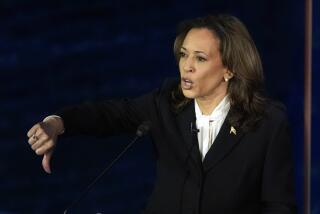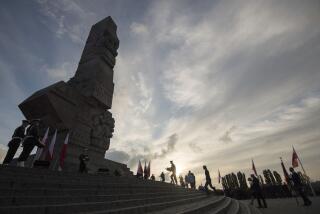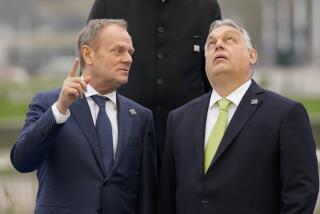For Poland, plane crash in Russia rips open old wounds
Reporting from Moscow â The plane crash that killed Polish President Lech Kaczynski on Saturday gutted a nationâs leadership and silenced some of the most potent human symbols of its tragic and tumultuous history.
It was, in a sense, a nation colliding with its past: The aircraft ran aground on a patch of earth that has symbolized the Soviet-era repressions that shaped much of the 20th century, near the remote Russian forest glade called Katyn where thousands of Polish prisoners of war were killed and dumped in unmarked graves by Soviet secret police in 1940.
The toll cut a swath through Polandâs elite. The 97 dead included the army chief of staff, the head of the National Security Bureau, the national bank president, the deputy foreign minister, the deputy parliament speaker, the civil rights commissioner and other members of parliament.
Also aboard the plane were war veterans and surviving family members of Poles killed by the Soviets. There was 90-year-old Ryszard Kaczorowski, Polandâs last âpresident-in-exileâ during the Soviet years. And Anna Walentynowicz, the shipyard worker whose dismissal in 1980 sparked the Solidarity union protests that eventually led to the collapse of Polish communism and made the symbolic first chink in the Berlin Wall.
And of course, Kaczynski, a former Warsaw mayor who had been imprisoned for his opposition to communism.
âThe contemporary world has not seen such a tragedy,â said Polish Prime Minister Donald Tusk, who as head of government holds the reins of power in the country. He called for two minutes of silence at noon Sunday.
The pavements of central Warsaw were transformed into a sea of light as late-night mourners burned thousands of candles. On Pilsudski Square, a trail of flickering flames stretched more than 50 yards from the Grave of the Unknown Soldier to the towering white cross marking the site where Pope John Paul II first said Mass to his compatriots in 1979.
Flying on a 26-year-old Soviet-designed plane, the presidential delegation was headed for a Roman Catholic Mass to mark the 70th anniversary of the deaths at Katyn. It was to be a tribute to long-smothered truth.
The massacre was denied for decades by the Soviet Union, and even today Russian reluctance to open the investigation files on the Polish prisoners remains a deeply sensitive topic between Moscow and Warsaw. To many Poles, the very name Katyn is shorthand for decades of secret grief and impotence in the face of Soviet power.
âI just have this feeling that Katyn is a sort of diabolical place in Polish history,â said Tomasz Lis, a prominent Polish journalist and author. âItâs just unimaginable; itâs horrible.â
As the news spread, a shiver of repulsion ran through a shocked Poland.
âThis is unbelievable; this tragic, cursed Katyn,â Kaczynskiâs predecessor, Aleksander Kwasniewski, said on Polish television. âItâs hard to believe. You get chills down your spine.â
The tragic irony of the crash was so extreme that it seemed destined for conspiracy theory. Russian officials were careful to pledge in the first hours to closely involve Poland in the investigation. Russian Prime Minister Vladimir Putin, rushing to the scene of the crash, announced that he would personally head the inquiry.
Poland was invaded by the Soviet Union during World War II, and lived for decades under Moscowâs domination. Long after the fall of the Berlin Wall, ties with Russia remain strained by old anxieties over independence.
As the presidential plane winged toward the western Russian city of Smolensk on Saturday morning, thick cords of fog wrapped the city. On the ground, air traffic controllers urged the crew to land either in Minsk, the capital of Belarus, or in Moscow rather than risk navigating the fog, Russian officials said.
But time was pressing. The crew decided to risk the landing, and ignored the instructions from the air traffic controllers, the Russian air force said.
âThe Polish presidential plane did not make it to the runway while landing,â Smolensk region Gov. Sergei Antufyev told reporters. âTentative findings indicate that it hit the treetops and fell apart. Nobody has survived the disaster.â
On the ground, about 1,000 people, many of them Poles, were milling around the memorial site. A Polish priest was to say Mass once the presidential delegation arrived.
âWe were getting ready for the Mass and everybody was expecting the president to arrive any minute,â said Yan Rachinsky of Russiaâs Memorial human rights group. âSuddenly people started talking quietly about something. There were many concerned faces. . . . Soon people started running around and talking to each other. Everybody was wondering what was going on. It was an atmosphere of tension.â
The priest led a prayer. Then the Polish ambassador stepped up to break the news. The presidential plane had crashed, he told the crowd. There were no survivors.
âIt was a moment of complete shock,â Rachinsky said. âWe were standing there speechless. We couldnât believe it.â
Tears wetting nearly every face, Rachinsky said, the group went ahead with the Mass.
By late afternoon, 97 bodies were being packed into coffins and flown to Moscow for identification. The flight recorders had been found, and investigators were studying them for clues.
In an address shortly after the crash, Russian President Dmitry Medvedev was careful to emphasize recent improvements in relations between Russia and Poland.
âThese days we conducted memorial events in Katyn together grieving over the victims of totalitarian times,â Medvedev said. âAll Russians share your grief and mourning.â
Last week, Tusk, the Polish prime minister, traveled to Katyn to mark the massacre. In what was regarded as a turning point in the often frosty relations between Moscow and Warsaw, Putin also attended the ceremony.
Kaczynski, a frequent and outspoken critic of the Kremlin, was not invited to that ceremony.
Unlike Tuskâs visit, which was given prominent news coverage in Russia, Kaczynskiâs plans to attend Saturdayâs commemoration were all but unmentioned. A few weeks ago, the Russian Foreign Ministry publicly complained that Kaczynski had not sent official word of his planned visit. The ministry had heard of his intentions from press reports, officials said.
The crash throws Polish politics into uncertainty. Kaczynski was to run for reelection in October; a government spokesman said Saturday night that Poland would hold an early presidential election, but no date had been set.
The leading left-wing candidate, Jerzy Szmajdzinski, was aboard the plane. And Polish law calls for another of the candidates, speaker of the lower chamber of parliament Bronislaw Komorowski, to take over as head of state after the presidentâs death.
Kaczynski, 60, was elected to the presidency in 2005. He and his twin brother, Jaroslaw, were Soviet-era child actors who grew up to cut a prominent path through Polish politics. Kaczynski rose from the ranks of the Solidarity trade union before falling out bitterly with the groupâs leader, Lech Walesa, who went on to become Polandâs first post-Soviet president.
In 2006 and 2007, the early years of Kaczynskiâs presidency, his twin served as prime minister.
The circumstances of Kaczynskiâs death carry a particular irony because of his long-standing interest in shedding light on some of the more painful moments of Polandâs past. As mayor of Warsaw, he championed the construction of the Museum of the Warsaw Uprising, a tribute to the crushed resistance to the Nazis in 1944.
During his presidency too, Kaczynski frequently hearkened back to the heroic days of Solidarityâs struggle against communism.
âPoland needs to reconsider its mistakes,â he said in 2005.
âBut more than that, it needs a consensus based on truth.â
Times staff writer Sergei L. Loiko in Moscow and special correspondent Kate Connolly in Warsaw contributed to this report.
More to Read
Sign up for Essential California
The most important California stories and recommendations in your inbox every morning.
You may occasionally receive promotional content from the Los Angeles Times.










